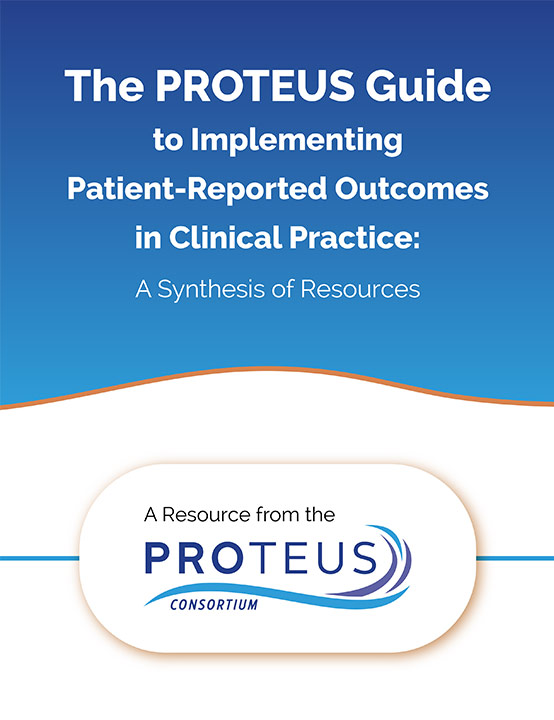PROTEUS — PRACTICE

Defining Goals: Chapter 1
In this excerpt (Chapter 1) from the PROTEUS-Practice Guide, you’ll find resources to help you navigate the first step in implementing PROs in practice: defining the goals for the PRO system.
This webpage contains the entire contents of Chapter 1. You can also download the PROTEUS-Practice Guide by clicking here.
Key Points
- Defining the goal(s) of patient-reported outcome (PRO) collection upfront is critical to inform the design of robust PRO systems
- PRO systems can be designed to meet multiple goals
- Examples of these goals include:
- Enhancing individual patient care (i.e., screening for problems, monitoring symptoms, assessing needs, promoting patient-centered care, assessing outcomes, informing shared decision-making)
- Improving population health
- Facilitating research and enhancing clinical datasets
- Informing health system reporting, billing, and value-based purchasing
Overview
An essential first step when implementing PROs in practice is defining the goals for the PRO system. There are numerous reasons to collect PROs at the point of care, and PRO systems can be designed to meet multiple objectives.
Leaders of health systems are increasingly interested in using PRO data to support diverse goals.
It is important to consider opportunities for aligning the collection of PROs to enhance the multiple goals of a healthcare system. The goals should drive how PRO systems are designed and implemented.
Questions and Considerations
A. What are potential goals for PRO systems?
To enhance individual patient care
- Patient care goals are often the primary focus of PRO systems
- Patient-care goals are diverse in nature and can include screening for problems, monitoring symptoms, assessing needs, promoting patient-centered care, assessing outcomes, and informing shared decision-making. These goals are further described in Table 1.1
To improve population health
- To support predictive analytic algorithms and other approaches to explore risks within and between groups, including equity analyses
To facilitate research
- To answer important research questions about the health of individuals cross-sectionally, over time, or in response to interventions
- To inform understanding of real-world effectiveness rather than efficacy
To improve quality (beyond using individuals’ PRO data to aid in their management)
- To improve care and quality, such as by comparing pooled data from one patient population to another or to normative benchmarks
- To facilitate multidisciplinary team communication by providing a common data source that diverse providers can use to discuss a patient’s health status as reported by patients themselves. This approach requires that team members of multiple disciplines be able to interpret PRO findings
- To identify strengths and weaknesses in the care a patient has been provided, for example, through use of audit/benchmarking data
- To serve as a useful indicator for clinicians regarding how their practice compares to other practices or normative data
- To provide comparative provider data to payers
- To compare the quality of care, though notably, this can be challenging due to confounders and limitations in case-mix adjustment
To inform billing, reporting, and value-based purchasing
- To inform automatic billing and coding of specific services
- To provide an outcome measure for value-based purchasing
Table 1.1 Patient-care goals for PRO systems
| Patient-care goal | PRO system application |
| Screening tools | Identify unknown health problems using one-time assessments. Note that this approach does not describe changes in health over time. |
| Symptom monitoring and management | Track patient outcomes over time to inform whether treatments and interventions are effective, or how they should be modified. |
| Self-monitoring and management | Allow patients to track and evaluate their own health over time. This information can be used for self-management as well as to facilitate conversations with the clinical care team. |
| Needs assessment | Identify and evaluate symptoms, functional impairment, and health risks. |
| Patient-centered care | Understand a patient’s own experiences and use this information to inform treatments and interventions. |
| Outcomes assessment | Evaluate the effectiveness of an intervention or a treatment. |
| Shared decision-making and decision aids | Facilitate discussion between providers and patients about patients’ priorities for life and care. PRO data can be included in decision aids to inform patients’ medical choices and help clarify patient values. Decision aids can include PROs and sometimes evaluate the impact of using a decision aid on PROs. |
B. How do you determine your PRO system’s goal(s)?
- Define the clinical goals of the PRO system before selecting the specific content to inform the development of a more robust PRO system
- Address multiple stakeholder needs, when possible, to economize organizational resources (see Chapter 3, Identifying, Engaging, and Training Users and Stakeholders)
- Consider healthcare setting characteristics that might influence PRO goals, including target population(s), urban vs. rural location, where the collection of PRO data will occur (e.g., inside or outside of healthcare setting), resources available, likelihood of compliance (both by the health providers and the patients and/or caregivers)
Relevant Primary Resources
The information presented here is an overview of defining goals for the PRO system. For more detailed information please see the following sources:
Background And Citing The Proteus-Practice Guide
Nothing in this Guide should be construed to represent or warrant that persons using this Guide have complied with all applicable laws and regulations. All individuals and organizations using this template have the responsibility for complying with the applicable laws and regulations or regulatory requirements for the relevant jurisdiction.
Each chapter of the Guide lists the key foundational resources that informed its content. To appropriately recognize the foundational resources, we encourage you to cite both the Guide and the relevant foundational resource(s). Recommended citations are provided here.
Suggested Citation
The PROTEUS Guide to Implementing Patient-reported Outcomes in Clinical Practice
A synthesis of resources. Prepared by Crossnohere N, Brundage M, Snyder C, and the Advisory Group, 2023. Available at: TheProteusConsortium.org.
Further Reading
The Guide draws primarily from the foundational resources cited in each chapter. Please click here to find a selection of other relevant references.

